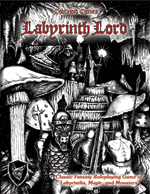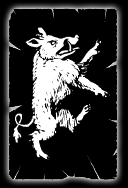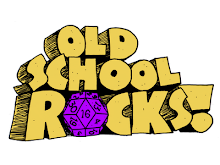4e gamers, that's who.
There has been a lot of talk about
D&D Next in the blogosphere of late. Now to begin with, I really must emphasize that
I have no horse in this race. I have my
Labyrinth Lord and I am happy. I have no reason to spend money on a new iteration of D&D
regardless of what exactly goes into it. I am NOT a "hater," I am just completely ambivalent about 5e, much as I was about
4e.
Yet with what I can glean from the recent blog posts -- I am not participating in the 5e playtest myself, so all this is
secondhand hearsay mind you -- I find myself in the surprising position of feeling a great deal of sympathy for all the 4e devotees
out there. Let me explain why.
My basic position is similar to the (much better informed and credible) one recently explicated in
an open letter to WotC Labgrrl posted on her blog,
UAD&D. (Thanks to David Maccauley for the
link to that post.) Labgrrl
writes:
"Immediately upon hearing rumors of #DnDNext, a significant number of fans of the current edition began to get confrontational
and disheartened in social media. They feel abandoned despite repeated assurances by the WOTC social networking team and even
some uninvolved third parties that continued new releases will happen. Their general view seems to be that there is limited
point in investment in further books and materials when it’s going to be rendered useless so rapidly.
"The problem with
planned obsolescence is that it can create huge feelings of ill-will towards a company [and] when
the economy is doing poorly or is in recovery, planned obsolescence backlash increases dramatically."
Labgrrl's comments remind me of a conversation I had with the manager of my
FLBS a few days ago. He asked me if D&D changed
drastically every time there was an edition change; he seemed particularly interested in the shift between 1e and 2e. While
noting that 2e is the one edition of D&D I have never played, so I am not terribly familiar with it, I nevertheless explained to
him that, in my view, I didn't see 2e as drastically altering the core rules set forth in the earlier editions. Sure, it
added skills and proficiencies, which were either nonexistent or only minimally present in earlier editions, but it did not
radically alter the core classes or the main thrust of the rules, as far as I know. In my view, the main changes 2e instituted were to
streamline the presentation of the rules, change the dominant style of the artwork, and to santize D&D vis-a-vis its alleged
demonic/Satanic content. (Please correct me in the comments if I have this wrong.)
So IF we assume that 0e through 2e were BASICALLY the same system, that's a 26-year run (1974-2000) of more or less completely compatible stuff. Hell, I am even
willing to lump 3e/3.5e/
Pathfinder in there because despite its major emphasis on skills and feats and hence character
"builds," 3e is still ESSENTIALLY a d20 system that hadn't yet introduced player appeasement measures like healing surges,
and hadn't severely shifted the game's emphasis from strategy to tactics. So that would give us a 34-year run of more or less compatible systems, before "strikers" and "defenders," the absolute necessity of battle mats, and the near-impossibility of PC death set in in 2008.
Even if we keep 3e/3.5 partitioned off as its own thing, those players (of which I was one for
about four years) at least had an eight-year run before 4e was introduced, and after that they had (and still have)
Pathfinder and Paizo.
By contrast, the 4e players have had only four years with their edition of choice. And, as far as I know, no guarantee of major corporate support for the edition once it is discontinued by WotC.
Justin Alexander's
analysis reveals that 5e's playtest version evinces a strong hearkening back to 3e, and he asks why he would
want to play what is essentially WotC's homebrew of 3e when he could just keep playing his own? It's a good question, and I would also ask, if 5e indeed ends up being really close to 3e rules-wise, what will keep the
Pathfinder crowd from continuing to play
Pathfinder, whose (expensive) rulebooks they already own? This
is a recession after all, and sadly it is distinctly possible that "
those jobs aren't coming back."
Daniel Proctor supports this view in his
commentary, stating that:
"[D&D Next] has to compete with all the other 3.x spinoffs that have been evolving for many years. What can 5e meaningfully
add that hasn't already been done? I think that's why D&D 5e feels like an also-ran at this point. The days where the Brand
alone was enough are past."
In slightly more concise (and vehement) terms, Biting Halfling over at Tenkar's Tavern
called 5e's playtest iteration "a
stripped down rebuild of 3rd Edition D&D + exactly four innovations." Again, I cannot confirm these views through my own
direct experience of the playtest, nor am I here to judge whether or not 5e will be any good. It's just that it seems like
5e, in returning to WotC's 3e roots, will leave 4e players out in the cold; the 4e crowd -- i.e., WotC's most loyal current
customer base -- will be those precisely most screwed by the changes made to bring 5e into closer relationship to the pre-4e
editions. This is a strange scenario that may well indicate a kind of
limited victory for we old-school gamers, but which also seems to indicate a mild form of corporate
schizophrenia on WotC's part, as Labgrrl so eloquently surmises.
Going the way of the Dodo.
Epilogue: My One Gripe
I suppose that while I am here I will add a brief comment about the one thing I do not like the sound of in those
secondhand playtest reports: the tendency in 4e and 5e to make it well nigh impossible for PCs to die.
The real threat of character death makes puts something serious at stake, and (in my view) encourages smart play rather than
relentless tactical hack-and-slash. The 4e-and-onward editions seem to encourage
"low death, low frustration"-style play,
as Roger the GS puts it, noting that in 5e "hit points are numerous, the margin of safety for low-level characters is great,
and healing remains as available as in 4th edition."
Jeff Rients shares my disdain for this kind of "softening" of D&D,
noting that "abstract 'healing surges' are about the most boring game mechanic ever."
More recently, Rients continued his
ruminations on this issue, bemoaning the fact that in 4e and 5e "my own personal D&D sweet spot, the hard-scrabble death-at-any-
moment fiasco of levels 1-3, is no longer supported. [. . .] For me, all other questions about what should and shouldn't be
in the new edition pale in comparison to this simple issue. If by the numbers I can't murder your starting PC with a single
lousy orc-stab, I don't want to play."
Patrick Wetmore echoes this concern in his
recent
post, in which he asks "What kind of delicate flowers have modern D&D players become?"
I totally acknowledge that it's "different strokes for different folks," yet I wonder the same thing Patrick does. Just last week, I
introduced about five neophyte gamers to
Labyrinth Lord; I started them at 1st Level and ran them through (most of) Tim
Shorts'
Knowledge Illuminates. During the short (3-hour) session, one PC was killed outright and another reduced to 1
hp. Something was very much at stake for that party; after their elf died, they were much more cautious, and really used that
10-foot pole that somebody thought to buy. I really loved seeing that; a classic D&D situation all the way!
So in the end, I am forced to agree with
Dan Proctor, who
writes:
"Criticize 3rd edition all you like (and I have), but it was a pretty successful edition. The problem is that when WotC left
an edition behind they didn't just revise the game into something else, they torched and salted the fields behind them each
time. Each time they tell their customers that there is something fundamentally broken and bad with the previous edition, and
in doing so they create a rift between the people who stay behind with the old edition and the people who take the bait for
the new edition."
An Afterthought
Was 4e released under the OGL? In other words, could it be retro-cloned?















